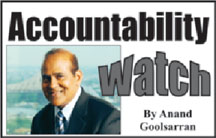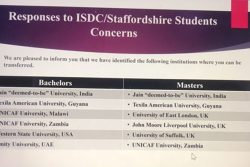Last Thursday, the National Assembly considered and approved two financial papers that were presented by Finance Minister Winston Jordan. The first financial paper (01/2015) covering an amount of $3.240 billion relates to the replenishment of the Contingencies Fund based on advances authorised by the former Minister of Finance during the more than three-year period from 25 October 2011 to 31 December 2014. The second financial paper (2/2015) relates to excess expenditure totalling $6.471 billion incurred during the more than two and one half-year period from 1 January 2012 to 16 July 2014 on the authority of the former Minister.
It is good that the new Administration is taking seriously the task of “cleaning up” the books of the Government and to have matters regularized in order to move forward without contamination with past issues that were left unresolved. The papers enjoyed relatively smooth passage, considering that they relate to expenditure incurred under the previous Administration.
Financial Paper 1/2015
 In accordance with Article 220 of the Constitution, the Minister of Finance is authorised to make advances from the Contingencies Fund if he/she is satisfied that an urgent need exists for expenditure for which no other provision exists. The urgency of the expenditure is elaborated on by Section 41 of the Fiscal Management and Accountability (FMA) Act which provides for the Minister to approve of a Contingencies Fund advance if he is satisfied that an urgent, unavoidable and unforeseen need for expenditure has arisen for which: (a) no moneys were appropriated, or the sum appropriated is insufficient; (b) moneys cannot be reallocated under the Act; and (c) the expenditure cannot be deferred without injury to the public interest.
In accordance with Article 220 of the Constitution, the Minister of Finance is authorised to make advances from the Contingencies Fund if he/she is satisfied that an urgent need exists for expenditure for which no other provision exists. The urgency of the expenditure is elaborated on by Section 41 of the Fiscal Management and Accountability (FMA) Act which provides for the Minister to approve of a Contingencies Fund advance if he is satisfied that an urgent, unavoidable and unforeseen need for expenditure has arisen for which: (a) no moneys were appropriated, or the sum appropriated is insufficient; (b) moneys cannot be reallocated under the Act; and (c) the expenditure cannot be deferred without injury to the public interest.
The circumstances under which advances can be made from the Contingencies Fund is akin to a natural disaster, such as a severe flood e.g. the Great Flood of 2005, an earthquake, or civil war, where it is not possible to convene Parliament for the purpose of approving the related expenditure. None of this happened during the period 25 October 2011 to 31 December 2014, and whilst there was no Parliament during the period 10 November 2014 to 31 December 2014 because of its prorogation, there was an approved budget for 2014. In other words, there was no justifiable reason for the granting of advances from the Contingencies Fund which is an emergency fund under the control of the Minister. The Minister has a duty not to abuse the authority vested in him by authorizing advances from the Contingencies Fund to incur expenditure that are of a routine nature.
The total of the amounts permitted to be drawn from the Contingencies Fund cannot exceed two per cent of the estimated annual expenditure of the preceding year, as reflected in the National Estimates, or such greater sum as the National Assembly may approve. However, at the very next sitting of the Assembly following the grant of the advances, the Minister is obliged to submit a report (in the form of a Financial Paper), specifying: (a) the amounts advanced; (b) to whom the amounts were paid; and (c) the purpose of the advances. Having considered the Paper, the Assembly will pass a Supplementary Appropriation Act which authorises withdrawal from the Consolidated Fund to bring to account the expenditure and to replenish the Contingencies Fund.
A review of the list of advances granted from the Contingencies Fund during the period in question indicates that most, if not all, of the advances did not satisfy the criteria for the grant of such advances. We do not know what happened prior to 1992 because there was no financial reporting and audit of the public accounts for ten years. What we do know is that the abuse/misuse of the Contingencies Fund is not new and can be traced back to the early 1990s. This abuse/misuse has been the subject of adverse comments in varying degrees from the Auditor General in almost every report since then.
It should be pointed out that the advances were used to incur public expenditure, and there was no act of misappropriation of funds. It is, however, a question of successive Ministers of Finance abusing their authority because of their ready access to the Contingencies Fund. Instead of going back to Parliament to request additional funding and to provide the necessary justifications for their requests, it was more expedient for them to resort to the use of the Contingencies Fund and to later seek supplementary estimates to regularize matters.
And successive Parliaments have been very lenient on their Ministers of Finance when it came to approving the related supplementary estimates to regularize the expenditure and to replenish the Contingencies Fund. Because of this, a chronic situation had developed over the years, culminating in the latest situation where the National Assembly on 30 December 2015 was faced with Financial Paper 01/2015 covering the staggering sum of $3.240 billion. Who is to blame? What form of sanctions will be imposed on the former Minister of Finance, given the magnitude of the amount involved? When are we going to see a discontinuation of the practice of abuse/misuse in the use of the Contingency Fund, with the Assembly a helpless bystander rubberstamping the actions of the Minister? True, the abuse in the use of the Contingencies is one of the reasons for the tabling of the motion of no confidence against the then Administration which precipitated the prorogation of Parliament, its subsequent dissolution and the holding of fresh elections. However, we need to nip the matter in the bud by having in place concrete measures to stop the abuse.
Financial Paper 2/2015
If we liken Financial paper 01/2015 to that of a great flood, then we must consider Financial Paper 2/2015 a tsunami in the context of public financial management. The circumstances giving rise to the latter is a complicated piece of constitutional issue that was the subject of two rulings by the Chief Justice: the 2012 budget cuts; and the $4.544 billion excess expenditure incurred in the first half of 2014.
In accordance with Article 218 (3), if in respect of any financial year it is found that any moneys have been expended for any purpose in excess of the amount appropriated for that purpose by the Appropriation Act or for a purpose for which no amount has been appropriated by that Act, a statement of excess showing the amount spent shall be laid in the Assembly.
It is important to note the words “if it is found”. In the context of this article, excess expenditure is a by-product of the operations of the budget where expenditure is inadvertently incurred in excess of the budgetary requirements. The discovery is based on a year-end “stocktaking exercise” involving the review of expenditure incurred against budgetary allocations. It follows that one cannot proactively or deliberately set out to incur excess expenditure and argue a case that the Constitution allows for this practice, as is the case giving rise to Financial Paper 2/2015.
While many may fault the ruling on the 2012 budget cuts case, the Chief Justice has made amends when he considered that the $4.544 billion excess expenditure that the then Minister of Finance had authorised, was a violation of the Constitution. Little did we realise that such excess expenditure had also been incurred in 2012 and 2013. The combined total of the excess expenditure for the period 1 January 2012 to 16 June 2014 was $6.471 billion. Extrapolating, in all probability an additional $4 billion would have been expended during the period 17 June to 31 December 2014 for which the related statement of excess expenditure is yet to be presented to the Assembly. This will give a whopping $10.5 billion in excess expenditure vis-à-vis the approved budgets for the period 2012 to 2014!
By Article 219 (2), when the statement of excess is approved by the Assembly by resolution, that resolution becomes the authority for the issue of the sums in question from the Consolidated Fund. These amounts are to be included in a Supplementary Appropriation Bill. Traditionally, a Supplementary Appropriation Act is the authority for withdrawing the related amounts from the Consolidated Fund. In the case of the excess expenditure in question, since the funds had already been withdrawn from the Fund, the Supplementary Appropriation Act represents the retroactive approval for the withdrawal and the authorization of the expenditure already incurred. It does not trigger a further withdrawal from the Consolidated Fund.
The audited public accounts for 2014 showed no excess expenditure in the context of the above since, by Cabinet decision of 10 November 2014, the day Parliament was prorogued, the amounts that the Assembly had declined to approve were “restored” and shown as approved allocations. In this regard, the comments of the Auditor General are worthy of serious noting:
According to the Current Estimates for 2014, the sum of $1.336 billion was submitted to Parliament for approval. However, there was a budget cut and the funds were not approved for Programme 011 – Administrative Services for the year 2014. Approval was subsequently granted for the restoration of the budget cuts in the sum of $1.336 billion vide Cabinet Decision dated 10 November 2014. As at 31 December 2014, amounts totalling $1.283 billion were expended, as shown below:”
There was no other comment from the Auditor General on the matter, which suggests that he accepted the Cabinet decision to amend the budget. Suffice it to state that it is not within the authority of Cabinet to restore budgetary allocations specifically disallowed by the Assembly. Such an act is not only a usurpation of the role of the Legislature in the monitoring and control of all public expenditure but also undermines the functioning of such an important institution of the State, indeed the highest decision-making body of the land.








